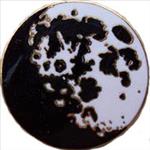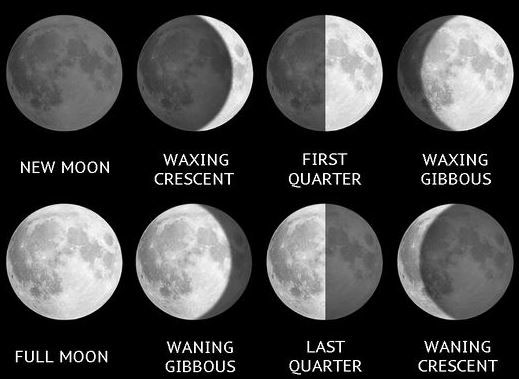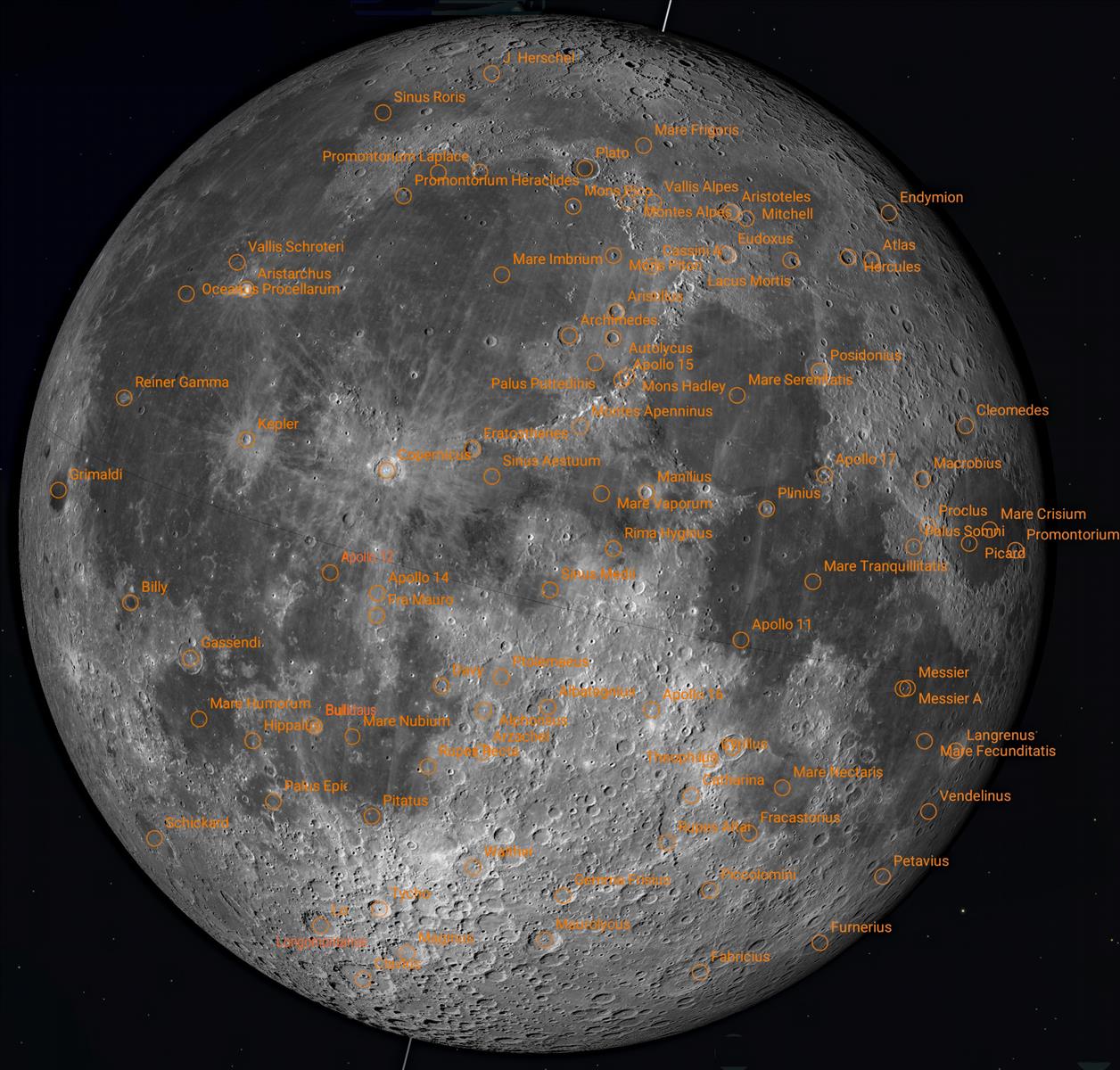
AL Lunar Observing Program To qualify for the AL's Lunar Observing Program certificate and pin, observe 100 features on the moon. These 100 features are broken down into three groups: 18 naked eye, 46 binocular, and 36 telescopic features.
Phases of the moon

Gibbous has its origins in the Latin noun gibbus, meaning "hump. It was adopted into Middle English to describe rounded, convex things.
Age Information
| Phase | Days Old | % Illuminated |
|---|---|---|
| New | 0,29.5 | 0 |
| Waxing Crescent | ~3.7 | 25 |
| First Quarter | ~7.4 | 50 |
| Waxing Gibbous | ~11.1 | 75 |
| Full Moon | ~14.8 | 100 |
| Waning Gibbous | ~18.5 | 75 |
| Last Quarter | ~22.1 | 50 |
| Waning Crescent | ~25.8 | 25 |
Moon with program objects denoted

From SkySafari 7 Pro
Phases of the moon Figures on the moon sketches Figures on the moon with pictures New Moon in Old Moon's Arms Old Moon in New Moon's Arms Lunar Rays NASA Tour of the moon Apollo Landing Sites
Features on the moon
NOTE: All are impact craters unless otherwise noted. Albategnius Alphonsus Archimedes Aristarchus Aristillus Aristoteles Arzachel Atlas Autolycus Billy Bullialdus Cassini Catharina Clavius Clavius craterlets Cleomedes Copernicus Cyrillus Davy Endymion Eratosthenes Eudoxus Fabricius Fra Mauro Fracastorius Furnerius Gassendi Gemma Frisius Grimaldi Hercules Hippalus Hipparchus J Herschel Kepler Lacus Mortis (Lake of Death) Langrenus Longomontanus Macrobius Maginus Manilius Mare Crisium (Sea of Crises) Mare Fecunditatis (Sea of Fertility) Mare Frigoris (Sea of Cold) Mare Humorum (Sea of Moisture) Mare Imbrium (Sea of Showers) Mare Nectaris (Sea of Nectar) Mare Nubium (Sea of Clouds) Mare Serenitatis (Sea of Serenity) Mare Tranquillitatis (Sea of Tranquility) Mare Vaporum (Sea of Vapors) Maurolycus Messier/Messier A Mitchell Mons Hadley (mountain range) Mons Pico (solitary mountain) Mons Piton (isolated mountain) Montes Alpes (mountain range) Montes Apenninus (mountain range) Oceanus Procellarum (mare, Ocean of Storms) Palus Epidemiarum (mare, Marsh of Epidemics) Palus Putredinis (mare, Marsh of Decay) Palus Somni (Marsh of Sleep) Petavius/Petavius Wall Picard Piccolomini Pitatus Plato Plinius Posidonius Proclus Promontorium Agarum (mountainous cape) Promontorium Heraclides (mountainous cape) Promontorium Laplace (mountainous cape) Ptolemaeus Reiner Gamma (lunar swirl) Rima Hyginus (volcanic crater, lunar caldera) Rupes Altai (escarpment) Rupes Recta (linear fault type of escarpment, "Straight Wall") Schickard Sinus Aestuum (Seething Bay) Sinus Iridum (Bay of Rainbows) Sinus Medii (Middle Bay) Sinus Roris (Bay of Dew) Theophilus Tycho Vallis Alpes (Alpine Valley) Vallis Schroteri (Rille, Schroter's Valley) Vendelinus WaltherWhen To Look
| The Straight Wall - Look for it as a hairlike shadow about 8 or 9 days after new moon, or as a straight bright line about 22 or 23 days after new moon. |
| Ptolemaeus - Lies near the center of the moon and can best seen a few days either side of first and last quarter. Due to setting time, first quarter ~7 days preferred. |
Q & A
| Q: Why do some craters have central peaks? A: If an impactor is large enough, some of the material pushed toward the edges of the crater will slump back toward the center and the rock beneath the crater will rebound, or push back up, creating a central peak in the crater. |
| Q: What is albedo? A: Albedo is ratio of the light received by a body to the light reflected by that body. Albedo values range from 0 (pitch black) to 1 (perfect reflector). Our Moon has a very low albedo (0.07), while Venus has a high albedo (0.60). |
| Q: What is a mountainous cape? A: A cape is an elevated landmass that extends deep into the ocean, sea or lake |
| Q: What is a promontorium? A: 1) a raised mountainous cape 2) a high ridge of land or rock jutting out into a body of water; a headland. 3) a bluff, or part of a plateau, overlooking a lowland. |
| Q: What is a lunar swirl? A: Lunar swirls are bright, often sinuous features with the appearance of abstract paintings. Crustal magnetism is thought to be the source. Solar radiation bombards the Moon, but pockets of magnetic anomalies act as a sunscreen, shielding the brighter parts of the lunar surface from solar radiation and "sunburn." The magnetic "sunscreen" redirects solar wind particles to areas just around magnetic bubbles, where chemical reactions darken the surface. This creates the distinctive swirls of darker and lighter material that are so prominent. |
This page last updated on 2/5/2024 9:57:20 AM. If you have comments or suggestions, email me at webmaster@jscheetz.com